An A-Z of leading figures involved in the 1884 Babbacombe murder case.
Index:
Barbor, Captain | Bennett, Thomas | Berry, James | Blatchford, Mary | Bolder, Ann | Boughton, Police Constable | Bulled, Jessie Augusta Widger | Carter, Isodore | Chilcote, Herbert Nicholas | Farmer, Kate | Gasking, William | Gladstone, Herbert | Hacker, Sidney | Hamilton, Captain de Courcy | Harcourt, William Vernon | Harrington, Cornelius | Harris, Eliz. (aka) Anne | Harris, Elizabeth | Harris, Richard | Keyse, Emma Ann Whitehead | Lee, John Henry George | Manisty, Sir Henry | Meech, Julius | Neck, Eliza | Neck, Jane | Nott, Abraham | Pearce, George | Phillips, George | Pitkin, Reverend | Richards, William | Ridley, Matthew White | Rounsfell, Police Constable | Russel, George | Salter, William | Searle, William | Steele, William Stott | Stephenson, Dr, Thomas | Stiggins, William Gasking | Sutton, Charles Henry | Templer, Reginald Gwynne | Whitehead, George
Barbor, Captain Douglas – Superintendent of Torquay Police
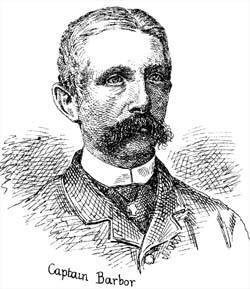
Born Cawnpore or Bengal, India 1839
Died London 1920 (unconfirmed).
“On Saturday the 15th November 1884 from information I received from Sergt. Nott I proceeded to “The Glen” Babbacombe arriving there shortly after 7.00 am. In company with Sergt. Nott I went into the dining room & examined the room very minutely without disturbing anything. I found that the room had been on fire, the wall behind the door being burnt, also the Sofa and Chairs, there were heaps of papers & old letters under the sofa & chairs which had also been fired, portions of the wall had apparently been knocked down, & the shutters of the windows opposite the door were shut”. “I then said to him “From the enquiries I have made all the doors and windows were locked at night & were found so when the fire was discovered. That Miss Keyse had been murdered & that it must have been done by a man & as you are the only man in the house, the Sergeant will charge you & you will be arrested on suspicion. ” Lee replied “On suspicion, oh all right.”
Captain Douglas Barbor served in the Devon Police Force for 25 years after serving in the India Police. He joined Torquay Police in 1884 after spending 14 years at Honiton Police. In 1891 he applied (and failed) for the position of Chief Constable of Police, Devon on the retirement of Gerald de Coucy Hamilton. He retired in November 1895 on which he recieved an annual penson of £105 12s 1d. According to the Exeter Flying Post – Saturday 18 September 1897, Captain Barbor, now living in Paignton, Devon, was experiencing financial difficulties. He was taken to court by a local chemist, Mr. B. Knight of Torquay, to whom he owed 17 5s 2d for “goods supplied”. In 1911 he was on the census at Maida Vale, London.
Bennett, Thomas – Coastguard Officer
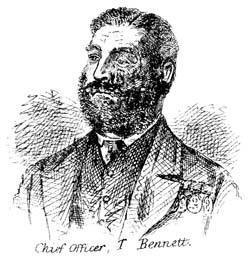
Born Southampton, 1831
“At about 4 o’clock I was awoke by (a? Mr.?) Harris and proceeded to Miss Keyse’s house. On the way I saw John Lee carrying a bucket. He was dressed in a pair of trousers, a shirt, a collar fastened by a stud. I went into the dining room. Gasking, Harris and two of my men were there putting out the fire. I went upstairs went into the bedroom on the left where the feather bed had been on fire but extinguished”.
Berry, James – Hangman

Born 1852, died 1913
English hangman between 1884 – 1892 during which time he carried out around 200 hangings. He was the first British executioner to write his memoirs “My experiences as an executioner”. He was, like fellow hangman, Marwood, satisfied with his ‘calling’. James Berry had previously been a policeman in Bradford and had met Marwood and become familiar with his methods.
One of his most famous jobs was of John Lee on the 23rd February 1885 at Exeter prison. Normal preparations were made on the gallows in the coach house at Exeter prison but when Berry pulled the lever nothing happened. Officers stamped on the trap but to no avail and Lee was then taken back to his cell whilst the gallows was tested. It worked perfectly. The process was repeated with the same result and again the trap worked perfectly after Lee was removed. After the third unsuccessful attempt the governor halted the hanging whilst he obtained directions from the Home Office.
Blatchford, Mary – Lady’s Maid, Compton House
Born Ipplepen Devon, 1843.
By 1901, Mary Blatchford was a Domestic Housekeeper for the Devon Clay Merchant, William Watts, at The Firs, at Wolborough in Newton Abbot.I heard a knocking at the door at about 5.30 am. John Lee was there. He said “Come down. Miss Keyse’s house is burning.” I then spoke to him out of the window. I asked him where is Miss Keyse. He said after a moments hesitation Miss Keyse is burnt. I then said where is she. He then said “She’s dead and you must tell Mrs Maclean”. He said “Jane told me to come & tell & you must tell Mrs Maclean”.
Boughton, Police Constable Frederick George – Torquay Police
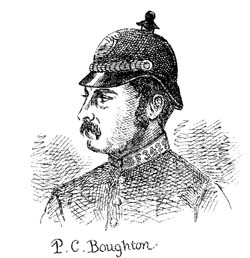
Born 1855
Died Bishops Tawton, near Barnstable, Devon August 1924
“He shewed me his left arm. He said “Isn’t my arm bad” He said “I cut it in hitting the dining room window to let out the smoke.” I said “That was foolish” He said “I was obliged to do it the smoke was so thick I could not find my way back to the door.” At 9 o’clock the same day Lee came to me. I was standing at the door of the back entrance. He was shaking. I said “You are feeling the cold”. He said “So would you if you had been running with only your shirt and trousers on.”
F. G. Boughton’s police career lasted 31 years. Retired February 1913 whilst serving at Ashburton Devon, his pension was 60 16s 8d. He held the King’s Coronation medal (this item was re-edited: 25 March 2012).
Bolder, Ann – Cook, Compton House
Born Brixham, 1833
“I saw John Lee on Saturday morning. He came into the house. He said to me “Miss Keyse’s house is on fire and she is burnt to death”. He shewed me that his arm was bleeding and he told me that he did it in breaking the glass to let out the smoke from the house. He turned up his sleeve to show me”.
Bulled, Jessie Augusta Widger – Lee’s Wife
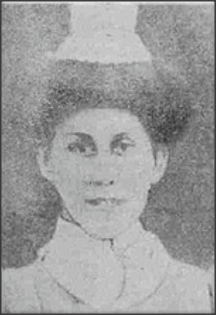
Born in 1875 at Tendering, Essex, married Lee on the 22 January 1909 at Newton Abbot, Devon and died in Surrey in 1960.
Before marrying Lee she was a much respected nurse at Newton Abbot Workhouse infirmary. Their marriage in 1909 captured the imagination of Lee’s followers. Although Lee claimed in the media he wanted a private marriage it still received considerable coverage (more about her here).
Carter, Isodore – Solicitor

Born Exeter, 1849, died 1936
“With the death of the late to Mr. Isidore James Carter, the well-known solicitor, of Torquay, who passed away at the advanced age of 87, there disappeared the last personal link with the notorious Babbacombe murder. Mr Carter was the prosecuting solicitor, and it was largely due to his own investigations on the spot that John Lee was arrested and accused of the murder.”
Chilcote, Herbert Nicholas – General Practitioner
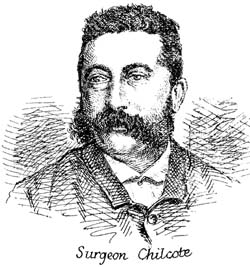
Born London, 1841, died St. Marychurch 1886
“To account for these marks the prisoner must have put on the coat with his shirt sleeve rolled up as there was no blood on the shirt.
The coat smelt strongly of paraffin. I examined a pair of trousers also shewn to me and and there is a patch of blood on one of the legs, a little to the back. I notice now a smell of oil about them. Did not so notice it when P.C. called upon me at my Surgery”.
“I do not think that any strength could have inflicted the wound in the throat with the knife produced”.
Farmer, Kate – John Lee’s girlfriend

Born Newton Abbot, 1864, died Plymouth 1938
Married James Parrish, 1886 and Frederick Pomeroy, c. 1889
Dressmaker, Kate Farmer lived at 3 Grafton Terrace, Ellacombe, Torquay, with her young brother Ernest, and their mother Harriet. Miss Farmer was, for a time engaged to John Lee. He wrote to Kate on 10 October 1884, suggesting that they call off their relationship, as he was unsettled and planned to ‘leave the town as soon as possible’. She later married James Parrish of St. Marychurch and after later moved to Plymouth with Frederick Pomeroy (born Plymouth, 1862).
Gasking, William Walling – Landlord, The Cary Arms
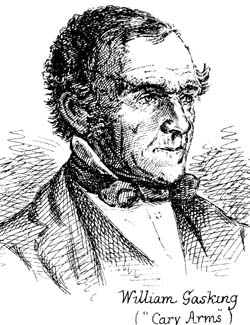
Born St. Marychurch 1809, died Babbacombe January 1896 (aka: William Walling Gasking)
Was reputed to have been very knowledgeable about the immediate vicinity. He was also a carpenter who, according to some sources, built Emma Keyse’s coffin. He was one of the first on the scene of the fire after the alarm was raised at 4.00am.
“When John Lee was helping me to carry out the body there was plenty of light in the dining room to see the wound in her throat. I saw it at once. I don’t think it possible that Lee could have failed to see the wound in the throat then.”
Mr. Gasking sold The Cary Arms in January 1890. In May 1890 he was selling his boats and fishing equipment.
Gladstone, Herbert John – Home Secretary, 1905 – 1909

Born Westminster, 1854
Youngest son of W.E. Gladstone (the British Victorian Prime Minister). It was Herbert Gladstone who finally agreed to release Lee from prison in late 1907.
Hacker, Sidney – Solicitor and Coroner

Born London, 1853
Died at Newton Abbot, Devon Tuesday 5th March 1929
Sidney Hacker had lived in Newton Abbot for over 40 years and was the son of a well-known engraver, Edward Hacker. In 1878 Sydney Hacker entered into partnership with Henry Michelmore the Newton Abbott solicitor and in 1879 Sydney took over the practice and was appointed Devon County Coroner. This was a position he held until 1922 when he was succeeded by Ernest Hutching of Torquay. He retired from his solicitors practice in 1917. In 1901 he was elected to the Newton Abbot urban council and retained the seat until 1911 when he retired Sydney Hacker was a well-known local Liberal. You can read here this obituary from the Western Times here.
Hamilton, Captain de Courcy – Chief Constable of Devon Police

Born 10 Oct 1828, Florence, Tuscany, Italy
Died 20 Nov 1913, Chelsea, London
Gerald de Courcy Hamilton had joined the Devon Police Force in 1856 and retired in December 1891.
Harcourt, Sir William Vernon – Home Secretary, 1880 – 1886
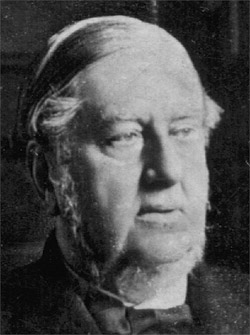
Born 1827, died 1904
Sir William George Granville Venables Vernon Harcourt had an illustrious political career. He was Home Secretary, Chancellor of the Exchequer, Leader of the Liberals in the House of House of Commons and was tipped to succeed Lord Rosebery as Prime Minister. He suffered politically after not co-operating with Rosebery over the South African War (Boer War) issue. As Home Secretary it was Harcourt who agreed that Lee should serve a life sentence for murdering Emma Keyse. He also ordered the enquiry into the failed execution at Exeter – a copy of which is transcribed here.
“Sir William Harcourt was one of the great parliamentary figures of the Gladstonian Liberal period. He was essentially an aristocratic type of late 19th century Whig, with a remarkable capacity for popular campaign fighting. He had been, and remained, a brilliant journalist in the non-professional sense. He was one of those who really made the Saturday Review in its palmy days, and in the period of his own most ebullient vigour, while Mr Gladstone was alive, his sense of political expediency and platform effectiveness in controversy was very acute. But though he played the game of public life with keen zest, he never really touched either the country or his own party with the faith which creates a personal following, and in later years he found himself somewhat isolated and disappointed, though he was free to express his deeper objections to the new developments in church and state.” (Source: The 1911 Encyclopedia Britannica)
Harrington, Cornelius – Fisherman, Babbacombe
Born Ireland, 1846, died Babbacombe 29th September 1897.
Suspected, by John Lee to have been at The Glen the night of the murder.
Harris, Elizabeth Hamlyn Esterbrook – Cook for Emma Keyse, step-sister of John Lee
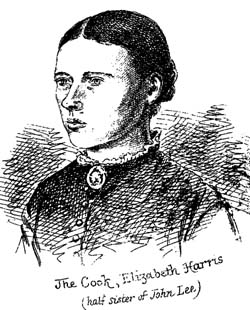
Born 1855 in Torbryan Devon, died in Maryborough, Queensland, Australia 26 February 1926
Elizabeth Hamlyn Easterbrook Harris was brought up by her maternal Grandmother, Bessie, at Pepperdon Farm, Kingsteignton. She started working for Emma Keyse in 1882 after employment with Edward Chant, Bank Manager of Teignmouth. At the time of the murder she was pregnant and there has been considerable speculation about the identity of the father and her actual involvement in the murder. Later she joined the Salvation Army and is alleged to have made ‘death bed confession’ surrounding this case. Her daughter, Beatrice was born at Newton Abbot workhouse on the 24th May 1885.
Harris, Eliz.Born Chudleigh, 1835
There is some confusion as to whether Richard Harris’s wife was called Elizabeth or Anne. The inquest and court archive refer to her as “Elizabeth”, the 1881 census refer to her as “Anne”. However the couple lived close to the scene of the crime at ‘Beach Cottage’.“A few minutes before 4 AM 15th November I went to Miss Keyse’s house. My husband and Mr. Gasking were in the outhouse. Went home and returned in about ten minutes. Then saw my husband and prisoner Lee fixing a (kieve?) under a tap. I had a lantern, I noticed Lee’s arm after my husband had gone into the house. There was blood on the arm, right arm, did not see any wound. I asked what was the matter with it and he said “I have cut it with the glass.” He had his shirt sleeves rolled up. I then went into the house, into the Dining Room , someone wanted to open the shutters but was prevented”.
Harris, Richard – Fisherman
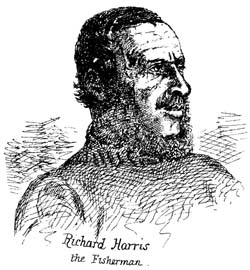
Born St. Marychurch, 1830
Husband of Elizabeth and / or Anne Harris of ‘Beach Cottage’.
“I was awoke by John Lee calling Mr. Gasking Walling. [I am a fisherman]. He shouted that Miss Keyse’s house was on fire. I opened the window and smelt smoke. I (roused) my son & dreamed & went dawn to Miss Keyse’s. I went to the Kitchen Room. Mr. Gasking and John Lee were there just coming out with the deceased. The deceased was on fire then in the upper part of the clothes. We threw some water over her. I helped Gasking carry the body to the boat house his since bought a light. There was no blood running from the body then”.
Keyse, Emma Ann Whitehead – The Victim

Born Edmonton, North London, 1816, died Babbacombe, 1884
The daughter of Thomas (died 1820) and Elizabeth Keyse (1783 – 1871), the spinster Emma Keyse inherited her property on her mother’s death. Little is known about her except it was reported that she was ‘deeply religious’ and was allegedly well connected. She was brutally murdered on the night of 14th November 1884. Following her killing her home was set on fire in several places.
Emma Keyse kept a diary – she was writing her journal the night she was murdered. No mention is made of the diary or whether it was used as evidence in court. On the surface, she was a very caring, upper-middle class person – and her relationship with John Lee and the rest of his lower class family is exceptional. After John Lee was prosecuted and found guilty of theft in 1883, Emma Keyse wrote to Lee whilst in prison and re-employed him after his release!
I have always believed that this relationship was definitely extraordinary for the Victorian age in which Emma Keyse lived and died.
Lee, John Henry George – Servant for Emma Keyse – The Accused

Born Abbotskerswell, Devon 1864, died Milwaukee, Wisconsin 1945
John ‘Babbacombe‘ Lee was twice in the employment of Emma Keyse. He was also in the navy, convicted of theft and accused of killing Miss Keyse. He is known as “The Man They Could Not Hang” because of the three failed attempts to execute him. He served a life sentence of penal servitude from 1885 – 1907 when he was released. Lee sold his side of the story to ‘Lloyds Weekly News’ and became a ‘personality’ through the music halls and silent cinema.
John Lee eventually became an ‘admired’ and quite rich personality. In reality he secretly fled (illegally) to America in 1911 with a bar maid who claimed, incorrectly (and also illegally), to be his wife. John Lee had deserted his real wife, Jessie, he so publicly married at Newton Abbot in 1909. Poor Jessie ended up at Lambeth Workhouse, pregnant with their second child and alone with no money. John Lee, a convicted British murderer, lived in America for 34 years with a woman claiming to be his wife and died in Milwaukee in 1945 – sixty years after he cheated the gallows at Exeter, UK. To-date, nothing is known of what became of Jessie Lee (nee: Bulled).
Manisty, Sir Henry – Judge of the Queen’s Bench Division
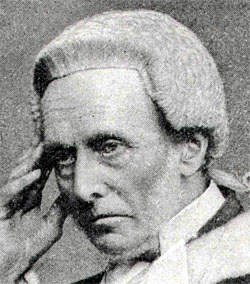
Born, Edlingham, December 1808, died, London 31st January 1890.
Henry Manisty, the son of the Rev James Manisty, Vicar of Edlingham, Northumberland, was born at Edlingham in 1808, educated and Durham Grammar School. He practised as a solicitor from 1831 to 1845. In 1845 he was called to the Bar at Gray’s Inn. He was appointed a QC in 1857 and in 1876 a Judge at the High Court of Justice, when he received the customary honour of knighthood. While trying a case at the law courts on January 24th 1890, he was struck by a paralysis, and though first he seemed to rally, he died on January 31st in the presence of his wife and all members of his family. Sir Henry was twice married; first in 1831 to Constantinia , daughter of Mr Patrick Dickson of Berwick on Tweed (this lady died in 1836); and secondly, in 1838 to Mary Ann, daughter of Mr Robert Stevenson, also of Berwick upon Tweed. An eloquent tribute to the memory of the Judge was paid in the Lord Chief Justice’s court: The Attorney General said that “during his 30 years on the Northern Circuit he never made an enemy or lost a friend”, and that on the bench “he displayed a patient industry, universal courtesy, and untiring consideration”. Lord Coleridge spoke of him as “a good judge, a good lawyer, and a good man”. He concluded by noting the great judicial qualities of Sir Henry; “his wide learning, his keen sense of duty, his warm and generous nature, his unswerving and incorruptible integrity”. Mr. Justice Manisty was Judge at Exeter Assizes: “You say you are innocent, I wish I could believe you” (to the accused, John Lee).
Meech, Julius – Babbacombe Police Officer
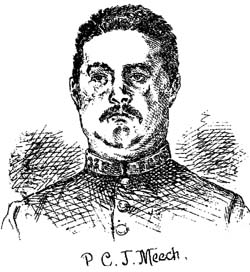
Born, Collaton, Devon, 1849
Died Paignton, Devon 16 September 1922
“I went as far as the door of the Dining Room when Lee came up against me. He had blood on both arms especially on the left arm. I asked him how he came by it. He said “I cut it in the glass”.
He said ” I put my fist through the glass to let the smoke out.”
The shutters were closed in the Dining Room when I got there. I then went up stairs to the Honeysuckle Room. Lee went upstairs with me. Lee pulled down one of the curtains (?) the wall. I attempted to pull down the other. The fire in the Honeysuckle Room appeared to have come up through the Dining Room. I looked in at the bedroom of the deceased. That appeared to have been a separate fire. The fire was quite out there.”
Julius Meech was in the Devon Police for about 20 years.
Molesworth, St. Aubyn R. W. – Barrister, MA (Oxford), MP for Helston, Cornwall
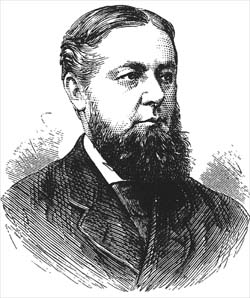
Born 1839
Neck, Eliza – Servant
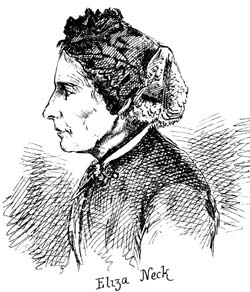
Born Torquay, 1815, died Babbacombe, 5th December 1885
Aged 69 at the time of the murder, Eliza Neck had been employed by Elizabeth Whitehead (Emma Keyse’s mother) and later by Emma Keyse since the mid 1840′s. At the Coroner’s inquest her evidence is alarmingly detached, she denies having any contact with the paraffin that set fire to the building in four places.
Both Eliza and Jane Neck continued to reside at The Glen for some time after the murder. After Eliza’s death, Jane moved to the home of William Gasking Stiggins at Prince’s Street in Babbacombe.
Neck, Jane – Servant
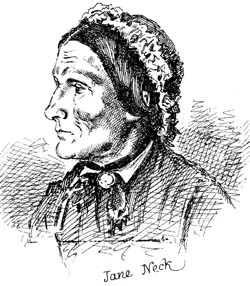
Born Torquay, 1817, died Babbacombe, 1891
Two years younger than her sister, Eliza,
Jane Neck had been employed by Elizabeth Whitehead and Emma Keyse since 1836. Like her sister, she had lived on the premises during that time.
“I was awoke by being called by the (cries?) of Elizabeth Harris. I went straight to Miss Keyse’s bedroom. It was all in a blaze. The partition was (firstly) on fire. The deceased was not in bed. I examined the bed. I found the Hot Water Bottle in the bed unmoved. The bed had not been slept in. I then left the room. As I was leaving the room John Lee who was outside took my arm to guide me to the (mistress?). He only said “Good God the fire.”
Nott, Abraham – Policeman

Born Rose Ash, Devon, 1841 Died Ashburton, Devon May 1913
It was Constable Nott who arrested John Lee on suspicion of murder.By 1901 he was a self employed ‘Carriage Inspector’ at Ashburton, Devon.“I have, since this inquiry was opened, let down the bed in the pantry. I find that between the end of the bed and the edge of the table which rests on brackets there are about four inches and a half. On the table there are (some?) small shelves & several trays. Had the brackets had been turned in and the table let down the shelves and trays must have fallen. It is impossible for a person to walk straight round the end of the bed between it and the table. They might get round it by going sideways and resting the hands on the bed. There is no other way of getting from the door of the pantry to the cupboard the right hand side of the fireplace without either going across the bed or (sliding?) round between the bed and the table. There is not room for any man to creep under the bed. The table was up in the morning on the brackets with the trays on when I saw it on Saturday morning”.
Pearce, George H. – Chief Coastguard Boatman
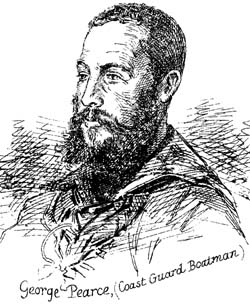
Born Babbacombe, 1853
“I was awoke by a noise of someone calling on Saturday morning at about 4 am. I got up & (dashed?) down stairs & ran to the house. I went into the dining room. Mr. Gasking was there and John Lee they were (knocking?) out the fire. The room was burning in parts. I noticed the pool of blood in the hall. I went upstairs to the Honeysuckle Room. The bed was smouldering. The (wall) was smouldering also I knocked away some of the partition. To knock out the fire I asked for a hatchet. Then Lee brought me one. The fire was got under in that room. I then went down to take charge of the body. When I saw John Lee he was in the dining room. He had his shirt & trousers on and a white collar fastened. I did not notice whether the shutters were open or not.
John Lee: “The last time I saw you was when you brought me the hatchet on the landing upstairs. I did not see you pass the Boat House to go to Compton.”
Phillips, George – Chief Boatman

Born Exeter, 1853
Later lived near Torquay Strand and became a ‘Glass and China Riveter and Umbrella Maker’.
“I was called on Saturday morning at about 4 o’clock and went to Miss Keyse’s house. I went into the house by the kitchen door & took two buckets of water & went upstairs. I went to the bedroom on the left. I remained there & attempted to put out the fire. When the fire up there was out I came downstairs. I helped to put out the fire there. The shutters ware fastened in the dining room. There was glass on the floor. When I saw Lee he had his collar on.”
Pitkin, Reverend John – Chaplain, Exeter Prison
Born London, London Spitafields, 1843
John Pitkin studied at the London College of Divinity, became a deacon in 1868 and was ordained as a priest in 1869 in York Diocese. He was curate of Hull, Yorkshire, 1868 – 1871 and of Kingston-upon-Thames, Surrey 1871-1873. Between 1874 – 1879 he was assistant chaplain of Wandsworth House of Correction and chaplain of Exeter Prison between 1879 – 1901. Between 1901 – 1902 he was chaplain of Winchester Prison, Hampshire, before becoming curate of Shapwick, Somerset in 1905 and vicar there in 1906.“Lee suffered much, and seemed to be almost unconscious of what was going on. He would rather have died, I verily believe, and the first words he uttered after he had been led back to his cell, and recovered from his state of apparent semi-unconsciousness, were, “Why am I not to die?”. On looking back upon the events as they happened, one cannot help deploring them; and one is driven to the conclusion that if only thoughtful care and supervision had been exercised in the erection of the drop, and in its examination prior to the attempted execution, all this public scandal would have been avoided”.
Richards, William – Babbacombe Postman
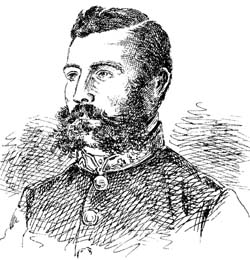
Born Winkley, 1850, died Torquay 1903. “I have known the prisoner for 6 years. I had a conversation with prisoner about 2 months ago on the hill leading down to the house. “I said to him are you hard at work”, he said “I am tired of it here if Misses does not get me a good place soon she will bloody soon wish she had. I will put an end to one before I leave.” Prisoner was quite (so?) (her?). I told him he better be careful, if his words that he made use of got among the public, or the police he might be apprehended should anything occur. Prisoner said he did not care. Prisoner was in the habit of carrying a stick of a dark colour with a knob to it. I asked him to give me the stick and he declined saying that it would give any one a hit on the head”.
Ridley, Matthew White, 1st Viscount – Home Secretary, 1895 – 1900
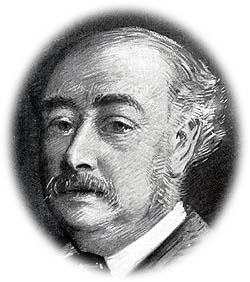
Born London, 1842, died, 1904
He entered Parliament as a Conservative in 1868 and was under secretary to the Home Office, 1878 – 1880, and in 1885 financial secretary to the Treasury. Home secretary, 1895 – 1900, he was made of Viscount in 1900.
Rounsfell, George Police Constable – Torquay Police
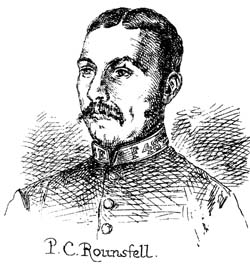
“I assisted Police Sergeant Nott in taking up the carpet in the hall. There were two pieces of carpet in the hall outside the Dining Room door the passage. The under piece was tacked down by the passage door and in the corner between the passage door and Dining Room door it was loose close to the (?). A door mat was on the top of all (cocoa nut mat). On the corner between the carpet and the floor I found a slipper and partly burnt stockings I don’t think the slipper has been burnt. Apparently these is blood on the bottom of the slipper, from the position I found these articles they must have been placed there by some one”.
Russel, George – Chimney Sweep
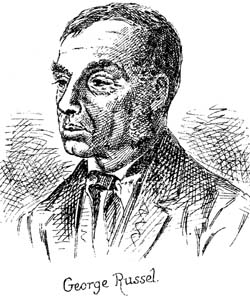
Born Honiton, 1815
“I live at St. Mary Church. I am a chimney sweep I was walking along from St. Mary Church towards Wellswood. I met a man with a light. It was John Lee. He said “I am going to Capt. McLeans wife to tell her sister is dead”. I said “Who is her sister” he said “Miss Keyse” I said “Is she really dead” He said “She is burnt to death”. I said “I am very sorry to hear it” he said “So am I. If it had not been for my sister we should all have been burnt to death.”
Salter, William – Oil Merchant, St. Marychurch
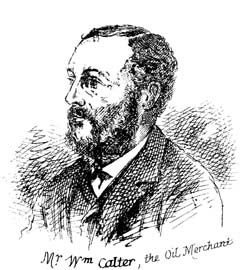
Born Exeter, 1840
“I am an Ironmonger – supplied oil to Miss Keyse’s house. On November the 6th that was the last date. It was (Alexandia? ) oil. That was the last I have supplied her with it was one gallon. The oil produced is (Alexandia?) oil – of the same kind as I supplied. There is no leak in the can produced.”
Searle, William – Boatman
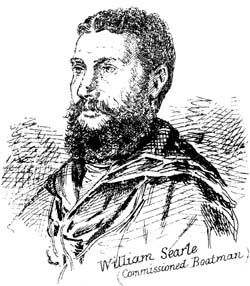
“Prisoner was there and said “I’ll get you something”. He brought the hatchet produced, brought it very quickly. He went downstairs. After the fire was out I was in the Dining Room . Up to this time I had not spoken to Lee. Lee came into the Dining Room , shortly after 7 it was. He put his arm on the sideboard and said “Oh, my dear arm”. I said “What is the matter” and he said he had cut it by breaking the window. I wouldn’t be certain but I think he had his coat on. He showed it to me, held up his arm so that I could see it. I turned over the sofa in this room and saw underneath a heap of charred papers. On the floor between couch and chair there was another heap of papers”.
Steele, Stott William – Physician and Surgeon
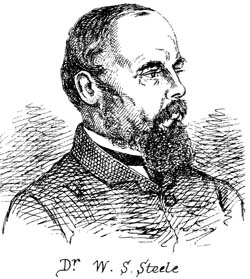
Born East Harsley, Yorkshire, 1828
Still practising at the age of 73 – by 1901 was living at Woodhouse, St. Marychurch.
“At about 9 o’clock on Saturday morning I went with Dr. Chilcott to see the body of the deceased. It was in the out building not far from the house. The body was wrapped in sheets but not in any other clothing. I observed that the right foot & leg were very much burnt. The left leg was not much burnt but there was one hole burnt in the (strelling?). The thighs were somewhat burnt. The abdomen was considerably burnt. The chest was (also?) more, burnt the sides were little burnt. The head and neck were not at all burnt. The hair was not even singed. On the throat there was a very extensive wound. It extended from the angle of the jaw on the left side a little below the ear downwards & across the throat a little beyond the (middle line?) of the throat. The wound had divided all the muscles, (the caroted?) artery, the jugular vein, the wind pipe, the gullet & the muscles in part of the (head) & it had notched the vertebrae of the neck. The wound, I think, was made when she was not quite dead. There were three wounds on the head. There was one at the back of the head. It was about an inch long through the scalp. The skull was not fractured there. There was another wound on the top of the head called the (vertex?). The scalp there was divided. The skull was fractured and depressed there”.
Stephenson, Dr. (later Sir) Thomas – Government Analyst and Toxicologist, Physician MRCS

Born Topcliffe, Yorkshire, 1838, died 1908
“I am a (Doctor?) of Medicine, a Fellow and (Examiner?) of the Royal College of Physicians of London, Lecturer on Chemistry & Medical (Junsprudence?) at Guys Hospital and Official Analyst to the Home Office. On 21st Nov. I received certain articles from Capt. Douglas Barbor. Viz a hatchet, a knife in paper, a woman’s night dress, mans shirt, a pair of socks and a lock of hair. And on the 27th Nov. I received from the same person a pair of trousers and an oil can. I have examined and analysed these articles. The hatchet produced is the one I examined. I found it marked with white plaster. On the back of the wooden handle there is a smear of blood. On the edge of the (own?) head there is a trace of blood and in the notch on the edge of the blade were a few blood corpuscles, the blood was that of a (mammalian?) animal or that of a human being. I am unable to say which I am unable to say whether it was male or female blood of a young or old person or arterial or venous. The blood on the handle had not lost the character of recent blood”.
Stiggings, William Gasking – Modelmaker

Sutton, Charles Henry – Hairdresser
“Charles Henry Sutton stated: I am a hairdresser of Union Terrace, St. Marychurch. On Saturday morning at 7.25, I met the prisoner (John Lee) in Plainmoor Terrace, St. Marychurch. He was then walking toward Torquay. I heard that there was a fire somewhere; and I asked Lee where it was. He said: It’s at my house, sir.””
Exeter and Plymouth Gazette –
Friday 28 November 1884 – The Tragedy at Babbacombe – The Inquest Resumed.
Templer, Reginald Gwynne – Solicitor
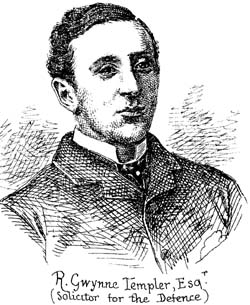
A young Devon solicitor with offices in Newton Abbot. He alleged that he and his family were closely acquainted with the victim, yet he was employed to work for the defence. Gwynne Templer in actual fact did nothing for Lee and was taken seriously ill during the trial.
Reginald Gwynne Templer was also acquainted to the Lee family – including the pregnant Elizabeth Harris (Lee’s step-sister). It was, according to John Lee, Lee’s parents who suggested that Templer should act for their son.
Two years after the murder he died of ‘paralysis of the insane’ (Victorian medical interpretation of what is referred to today as ‘syphilis’). Reginald Gwynne Templer’s role in this case is, today, subject for great speculation.
Whitehead, George – Half-brother of Emma Keyse
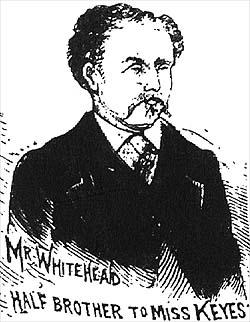
He lived in Edinburgh at the time of the murder and travelled to Torquay to attend the inquest at St. Marychurch.
“The deceased is my step sister. She was between 60 & 70 years of age. She was a spinster. I know the House called the Glen (Boathouse?). She had lived in the house for many years. I don’t know if she had made any will. I don’t think she was in the habit of keeping (secret) money in the house. I have known the house all my life. I arrived in Torquay on Sunday. I examined the house on the ( ? ) . I am perfectly sure that no housebreaking implement has been (and)(used?) from the outside. I examined the bedroom of deceased and the (interior?) of the house. I feel quite certain that no one could have got into the house unless they had been admitted”.
These politicians were in one way or another more than aware that inside a British prison was a man who held the secret to the Babbacombe murder.
Home Secretaries
Covering the period surrounding this case and Lee’s imprisonment:
23 April 1880 Sir William Vernon Harcourt
24 June 1885 Sir Richard Assheton Cross
6 February 1886 H.C.E. Childers
3 August 1886 Henry Matthews, Viscount Llandaff
18 August 1892 Herbert Asquith,1st Earl of Oxford and Asquith
29 June 1895 Sir Mathew Ridley, 1st Viscount Ridley
12 November 1900 Charles Thomson Ritchie,1st Lord Ritchie
11 August 1902 Aretas Ackers-Douglas, 1st Viscount Chilston
11 December 1905 – 1909 Herbert John Gladstone,1st Viscount Gladstone
Prime Ministers
Covering the period surrounding this case and Lee’s imprisonment:
1880 – 1885 William Ewart Gladstone
1885 – 1886 Robert Arthur Talbot – Gascoyne-Cecil Salisbury
1886 William Ewart Gladstone
1886 – 1892 Robert Arthur Talbot – Gascoyne-Cecil Salisbury
1892 – 1894 William Ewart Gladstone
1894 – 1895 Archibald Philip – Primrose Rosebery
1895 – 1901 Robert Arthur Talbot – Gascoyne-Cecil Salisbury
1902 – 1905 Arthur James Balfour
1905 – 1908 Sir Henry Campbell-Bannerman
